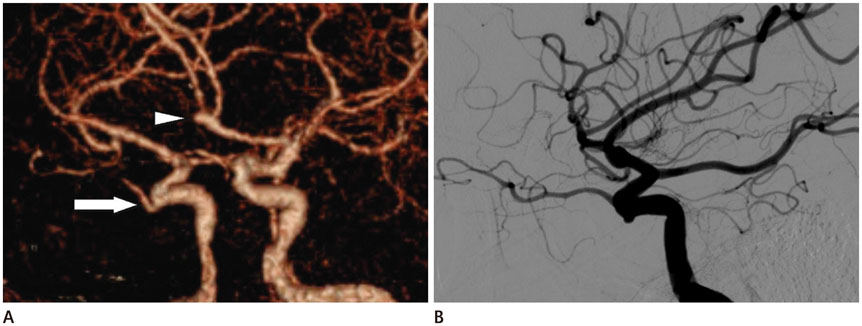J Korean Soc Radiol.
2016 Dec;75(6):446-449. 10.3348/jksr.2016.75.6.446.
Persistent Dorsal Ophthalmic Artery Arising from the Internal Carotid Artery: Report of Three Cases
- Affiliations
-
- 1Department of Radiology, Seoul Paik Hospital, Inje University College of Medicine, Seoul, Korea. hongage@unitel.co.kr
- KMID: 2360431
- DOI: http://doi.org/10.3348/jksr.2016.75.6.446
Abstract
- Normally, the ophthalmic artery (OA) arises from the supraclinoid segment of the internal carotid artery (ICA) and enters the orbit via the optic canal. A persistent dorsal OA is a rare variation that originates from the cavernous segment of the ICA and enters the orbit via the superior orbital fissure. To the best of our knowledge, persistent dorsal OA has not been described in the Korean literature. In this paper, we report three cases of persistent dorsal OA with review of the literature on embryogenesis and other origins of the OA.
Figure
Reference
-
1. Fiore DL, Pardatscher K, Fiore D, Zuccarello M, Iraci G. Persistent dorsal ophthalmic artery. Report of a case with associated fibromuscular hyperplasia of the extracranial internal carotid artery and multiple cerebral aneurysms. Neurochirurgia (Stuttg). 1981; 24:106–108.2. Uchino A, Saito N, Takahashi M, Kozawa E, Mizukoshi W, Nakajima R, et al. Persistent dorsal ophthalmic artery and ophthalmic artery arising from the middle meningeal artery diagnosed by MR angiography at 3 T. Surg Radiol Anat. 2013; 35:775–782.3. Uchino A, Saito N, Kurita H, Ishihara S. Double ophthalmic arteries arising from the internal carotid artery. Surg Radiol Anat. 2013; 35:173–175.4. Perrini P, Cardia A, Fraser K, Lanzino G. A microsurgical study of the anatomy and course of the ophthalmic artery and its possibly dangerous anastomoses. J Neurosurg. 2007; 106:142–150.5. Watanabe A, Hirano K, Ishii R. Dural caroticocavernous fistula with both ophthalmic arteries arising from middle meningeal arteries. Neuroradiology. 1996; 38:806–808.6. Rivera R, Choi IS, Sordo JG, Giacaman P, Badilla L, Bravo E, et al. Unusual origin of the left ophthalmic artery from the basilar trunk. Surg Radiol Anat. 2015; 37:399–401.7. Li Y, Horiuchi T, Yako T, Ishizaka S, Hongo K. Anomalous origin of the ophthalmic artery from the anterior cerebral artery. Neurol Med Chir (Tokyo). 2011; 51:579–581.8. Padget DH. The development of the cranial arteries in the human embryo. Contrib Embryol. 1948; 32:205–261.9. Lasjaunias P, Berenstein A, Brugge KT. Clinical vascular anatomy and variations. New York: Springer;2001. p. 1–72.10. Komiyama M. Letter to the editor-embryology of the ophthalmic artery: a revived concept. Interv Neuroradiol. 2009; 15:363–368.
- Full Text Links
- Actions
-
Cited
- CITED
-
- Close
- Share
- Similar articles
-
- Aneurysm at the Origin of the Uncal Artery Arising from the Internal Carotid Artery
- Infraoptic Anterior Cerebral Artery Arising from Contralateral Internal Carotid Artery: Case Report
- Aneurysm and Infundibular Dilatation at an Unusual Origin of the Ophthalmic Artery
- Strategy & Pitfalls of Internal Carotid Artery Aneurysm Surgery
- A Case of Giant Paraclinoid Aneurysm




